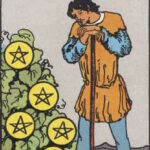Tarot cards have long intrigued individuals, presenting a blend of mysticism and psychology that invites interpretation and understanding. But how does this age-old practice align with Christianity? Can the rich imagery and symbolism inherent in tarot hold meaning within a Christian framework? This article delves into the intricate relationship between tarot card meanings and interpretations from a Christian perspective, offering insight, scrutiny, and perhaps an intellectual challenge to the reader: How can one reconcile contemporary spiritual practices with traditional Christian beliefs?
Understanding Tarot Cards
At their core, tarot cards serve as a tool for divination, traditionally used to harness intuitive insights and clarity. A standard tarot deck consists of 78 cards, divided into the Major Arcana and the Minor Arcana. The Major Arcana comprises 22 cards, each bearing profound symbolism. In contrast, the Minor Arcana consists of 56 cards, categorized into four suits, reflecting everyday trials and experiences. Those unacquainted with tarot may perceive it as mere fortune-telling, yet its deeper roots lie in psychological exploration and self-reflection.
The Christian View on Divination
Christianity’s stance on divination and the occult is notably cautious. Biblical verses, such as Deuteronomy 18:10-12, explicitly oppose practices such as fortune-telling, suggesting that seeking knowledge of the future through supernatural means deviates from God’s sovereignty. This poses a provocative question: Is tarot an avenue for self-discovery, or does it lead believers away from divine guidance?
The Symbolism of Tarot from a Biblical Lens
Each tarot card is imbued with multiple layers of meaning, often depicted through archetypal imagery resonant across cultures. The Fool, for instance, invites exploration of new beginnings, reminiscent of biblical themes of faith and trust in God. Meanwhile, The Tower symbolizes upheaval, akin to the trials faced by figures within scripture. Engaging with these symbols, one might argue that they can illuminate spiritual truths and provide a framework for personal reflection. However, this prompts contemplation: Can one truly extract spiritual significance from these images without falling into the traps of superstition?
Navigating Tarot’s Moral Landscape
As Christians engage with tarot, a critical moral inquiry emerges: how to traverse the delicate boundary between discerning meaningful insights and straying into the realm of forbidden practices. The High Priestess card, often associated with intuition and inner wisdom, can parallel the Christian belief in the Holy Spirit. This card illustrates the importance of listening to one’s inner voice, aligning with the Christian call to discernment through prayer and reflection. Thus, while the means may differ, the underlying intention can harmonize with Christian values, as long as practitioners maintain a clear understanding of their foundation.
Integrating Tarot into Spiritual Practices
Some Christians have found ways to incorporate tarot into their spiritual journeys, treating the cards as instruments for meditation and thought rather than divination. This approach often includes the use of tarot as a tool for journaling, helping individuals articulate their thoughts and emotions. A practice that encourages introspection can resonate profoundly with Christian teachings on the significance of self-examination. Yet, some may challenge this perspective, questioning if any utilization of tarot, regardless of intention, can truly align with a faith that prioritizes clarity in God’s word over ambiguous interpretations.
The Role of Intuition in Christianity and Tarot
Both Christianity and tarot emphasize the significance of intuition, urging believers to cultivate a deep awareness of their inner selves. The Empress card, symbolizing creativity and nurturing, can serve as a reminder of God’s abundant love and care. Drawing connections between these concepts evokes fundamental questions about the nature of spiritual understanding: Are intuition and divine revelation mutually exclusive, or can they coexist harmoniously in the pursuit of truth? Believers may find they can navigate these questions through prayerful deliberation, seeking understanding rather than judgment.
The Interpretative Spectrum
Much of the challenge lies in varied interpretations of tarot’s messages. The Death card, widely misunderstood, signifies transformation rather than physical demise. This concept parallels Christian beliefs surrounding resurrection and renewal. By viewing these symbolic elements through a lens of hope and divine purpose, one could argue that tarot could be viewed as a metaphorical representation of the spiritual journey—each card revealing a facet of the believer’s path toward fulfillment in Christ.
The Final Balancing Act
The intersection of tarot and Christianity symbolizes a broader cultural dialogue about faith, spirituality, and personal interpretation. As believers contemplate the role of tarot in their lives, the evaluative challenge remains: How does one affirm their faith while engaging with practices that might appear contradictory? This philosophical engagement fosters important discussions within faith communities, promoting understanding and coexistence amid differing beliefs.
In conclusion, while the worlds of tarot and Christianity may seem at odds at first glance, thoughtful engagement with the cards can yield profound insights, fostering personal growth and spiritual reflection. Each tarot reading could serve as an opportunity to explore faith more deeply, instigating conversations that move beyond simple dichotomies into a richer engagement with the divine. The question then arises once more: How can we, as seekers of truth, embrace the complexity of spiritual experiences and find meaning in the intricate tapestry of faith and intuition?








Leave a Comment